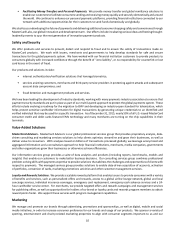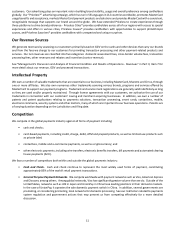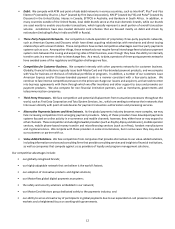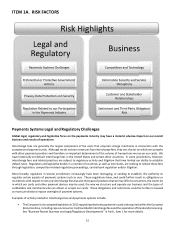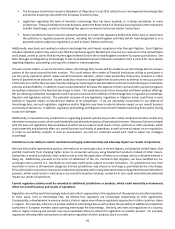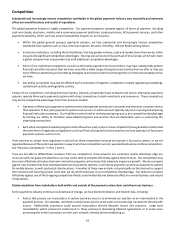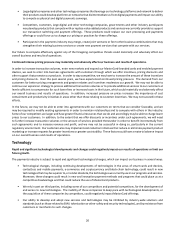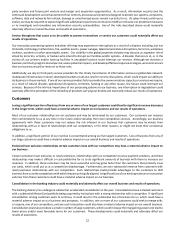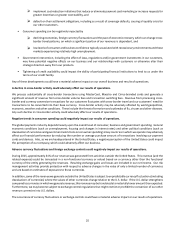MasterCard 2015 Annual Report Download - page 25
Download and view the complete annual report
Please find page 25 of the 2015 MasterCard annual report below. You can navigate through the pages in the report by either clicking on the pages listed below, or by using the keyword search tool below to find specific information within the annual report.19
Competition
Substantial and increasingly intense competition worldwide in the global payments industry may materially and adversely
affect our overall business and results of operations.
The global payments industry is highly competitive. Our payment programs compete against all forms of payment, including
cash and checks; electronic, mobile and e-commerce payment platforms; cryptocurrencies; ACH payment services; and other
payments networks, which can have several competitive impacts on our business:
• Within the global general purpose payments industry, we face substantial and increasingly intense competition
worldwide from systems such as Visa, American Express, Discover, UnionPay, JCB and PayPal among others.
• In certain jurisdictions, including the United States, Visa has greater volume, scale and market share than we do, which
may provide significant competitive advantages. Visa has also announced its purchase of Visa Europe, which will create
a global company that may provide Visa with additional competitive advantages.
• Some of our traditional competitors, as well as alternative payment service providers, may have substantially greater
financial and other resources than we have, may offer a wider range of programs and services than we offer or may use
more effective advertising and marketing strategies to achieve broader brand recognition or merchant acceptance than
we have.
• Our ability to compete may also be affected by the outcomes of litigation, competition-related regulatory proceedings,
central bank activity and legislative activity.
Certain of our competitors, including American Express, Discover, private-label card networks and certain alternative payments
systems, operate three-party payments systems with direct connections to both merchants and consumers. These competitors
may derive competitive advantages from their business models:
• Operators of three-party payments systems tend to have greater control over consumer and merchant customer service
than operators of four-party payments systems such as ours, in which we must typically rely on our issuing and acquiring
financial institution customers. Our inability to control end-to-end processing may put us at a competitive disadvantage
by limiting our ability to introduce value-added programs and services that are dependent upon us processing the
underlying transactions.
• Even when competitors operate programs that utilize a four-party system, these competitors have generally not attracted
the same level of regulatory or legislative scrutiny of their pricing and business practices as have operators of four-party
payments systems such as ours.
If we continue to attract more regulatory scrutiny than these competitors because we operate a four-party system, or we are
regulated because of the system we operate in a way in which our competitors are not, we could lose business to these competitors.
See “Business-Competition” in Part I, Item 1.
If we are not able to differentiate ourselves from our competitors, drive value for our customers and/or effectively align our
resources with our goals and objectives, we may not be able to compete effectively against these threats. Our competitors may
also more effectively introduce their own innovative programs and services that adversely impact our growth. We also compete
against new entrants that have developed alternative payments systems, e-commerce payments systems and payments systems
for mobile devices, as well as physical store locations. A number of these new entrants rely principally on the Internet to support
their services and may enjoy lower costs than we do, which could put us at a competitive disadvantage. Our failure to compete
effectively against any of the foregoing competitive threats could materially and adversely affect our overall business and results
of operations.
Disintermediation from stakeholders both within and outside of the payments value chain could harm our business.
As the payments industry continues to develop and change, we face disintermediation and related risks, including:
• Parties that process our transactions in certain countries may try to eliminate our position as an intermediary in the
payment process. For example, merchants could process (and in some cases are processing) transactions directly with
issuers. Additionally, processors could process transactions directly between issuers and acquirers. Large scale
consolidation within processors could result in these processors developing bilateral agreements or in some cases
processing the entire transaction on their own network, thereby disintermediating us.



